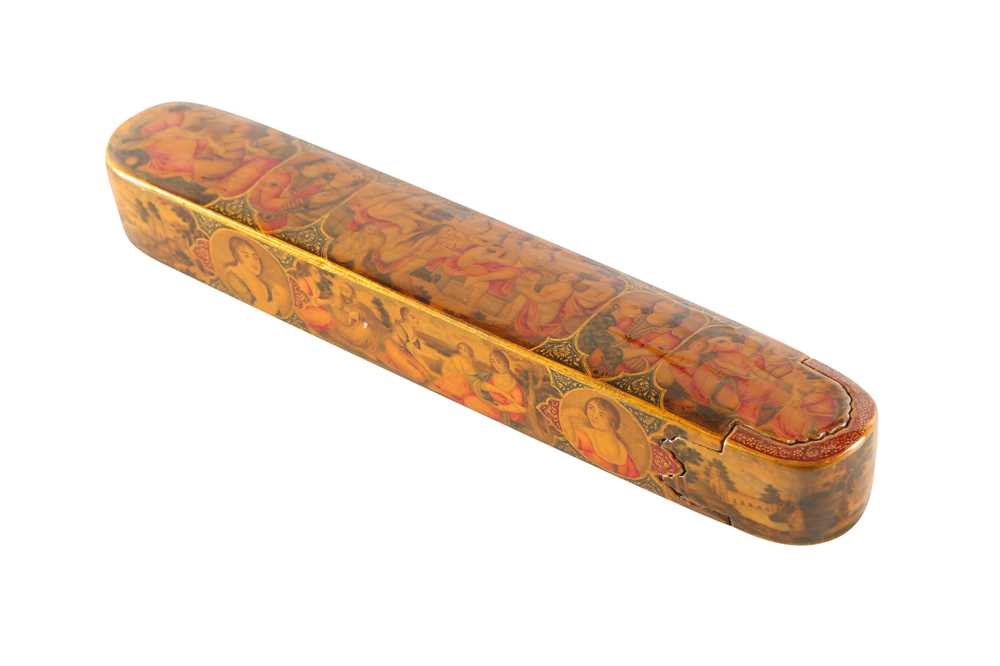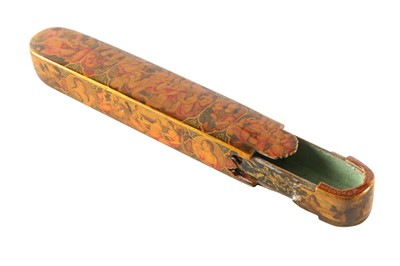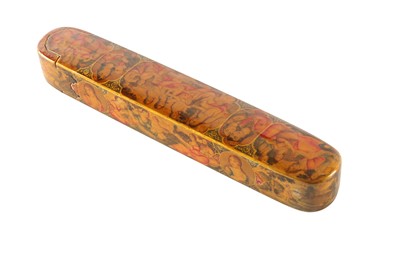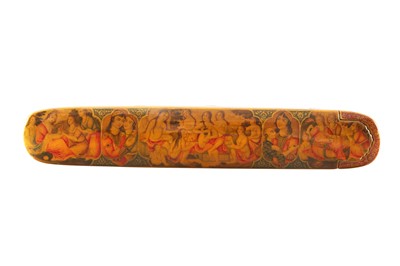28th Oct, 2022 11:00
Islamic Art - Property of a European Collector Part IV
A LACQUERED PAPIER-MÂCHÉ PEN CASE (QALAMDAN) WITH WESTERNISED FEMALE BEAUTIES
Qajar Iran, dated 1269 AH (1852) and inscribed 'Ya Shah-e Najaf' for Najaf Ali (active 1810 - 1860)
A LACQUERED PAPIER-MÂCHÉ PEN CASE (QALAMDAN) WITH WESTERNISED FEMALE BEAUTIES
Qajar Iran, dated 1269 AH (1852) and inscribed 'Ya Shah-e Najaf' for Najaf 'Ali (active 1810 - 1860)
With rounded ends and a sliding tray, polychrome-painted, heightened in gold, and lacquered, the decoration arranged in horizontal order within gilt lobed cartouches, the top and sides painted with group gatherings of Westernised beauties absorbed in different activities including bathing, banqueting, conversing, and admiring a floral bouquet and a parrot, alternating with smaller roundels with miniature portraits of Qajar beauties and beaus, some actively copying Western models with foreign outfits and accessories and some mirroring Qajar fashion standards, the central cartouche on the top signed Ya Shah-e Najaf and dated 1269 in red ink, more bucolic scenes and landscape views on the side edges, the underside of the case and the inner sides of the tray with an exquisite decoration in gold featuring hunting scenes with long rifles, traditional architectures, wildlife, and lush vegetation including flowers and grapes, all against a black ground, 23cm long.
Another Qajar qalamdan inscribed Ya Shah-e Najaf and dated 1272 AH (1855), once part of the same private European collection, was successfully sold in these Rooms, 29 April 2022, lot 50. The decorative program of both pen cases is undeniable analogous. Firstly, the subjects, including female group gatherings alternating miniature portraits in roundels, are arranged in the same horizontal order, encased within lobed gold cartouches and oval medallions. Some of the cartouches almost mirror each other in the way their subjects have been laid out, their expressions and attires, and their manners. Secondly, the underside of the case and inner sides of the sliding tray, areas which can usually be neglected or forgotten, showcase two impressive compositions in gold with both figural and vegetal motifs of great draughtsmanship quality. Thirdly, the inscription attributing both pen cases to the Qajar artist Aqa Najaf or Najaf 'Ali, one of the most celebrated Qajar lacquer master of the mid-19th century whose work flourished between 1810 and 1860 and often depicted Christian scenes and female beauties, presents distinct similarities in its calligraphic traits. It is therefore plausible to argue that the present pen case can be rightly attributed to this artist, like the other case sold earlier this Spring.
Sold for £1,875
Includes Buyer's Premium
Do you have an item similar to the item above? If so please click the link below to submit a free online valuation request through our website.





